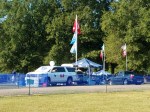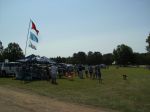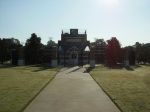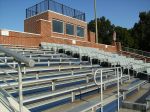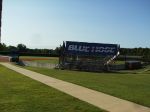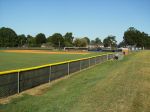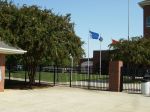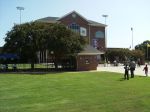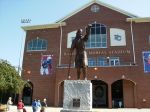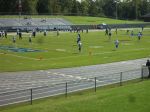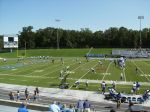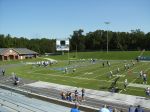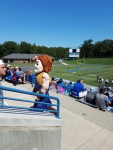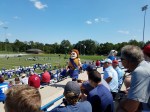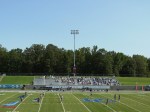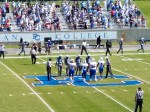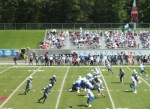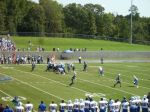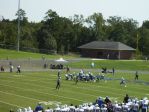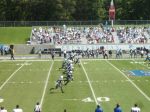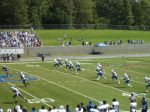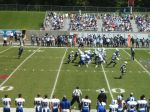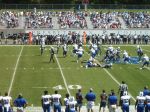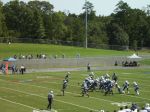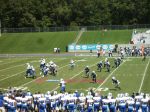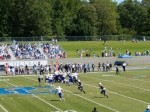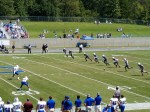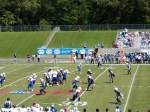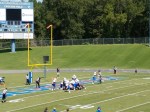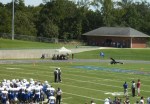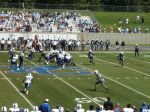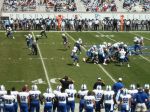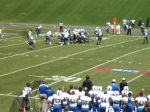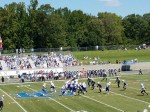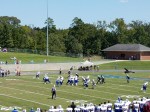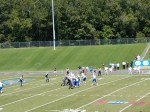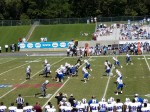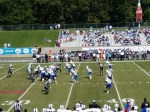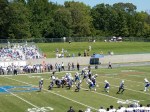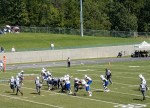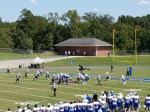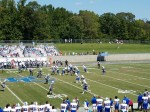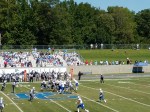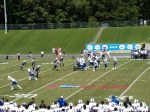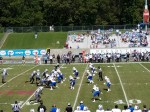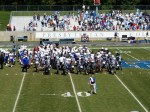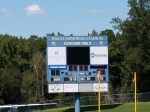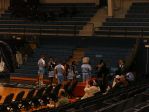In the past, I have written about tendencies in playcalling by the then-coach of the Bulldogs, Mike Houston (and his offensive coordinator, Brent Thompson, who took over as The Citadel’s head coach last season). I compared statistics over a rolling three-year period. Last year, for example, included numbers from Kevin Higgins’ last season in charge and the two years Houston helmed the program.
Now I’m going to take a look at what Thompson did in his first year running the show, and contrast those statistics with those from the 2015 and 2016 seasons for the Bulldogs (with a few exceptions where I don’t have readily available data for the previous campaigns).
My focus in this post will be on the following:
- down-and-distance run/pass tendencies (for The Citadel and its opponents)
- yards per play numbers (offense and defense, rushing and passing)
- certain defensive passing stats (including sacks, hurries, and passes defensed)
- success in the “red zone” (defined as scoring or preventing touchdowns)
- plays from scrimmage of 20 yards or more (“big” plays)
- fourth-down decision-making (for The Citadel and its opponents)
- situational punting (i.e. punting from inside the opponents’ 40-yard line)
- the coin toss (of course)
—
I have another post that focuses on assorted “advanced stats”, including success rate, explosiveness, field position, finishing drives, and turnovers — the “five factors” of college football. In that post, I’m also listing some stats related to success on first down and third down, some of which are particularly illuminating with regards to The Citadel.
I decided to split those numbers into a separate post for reasons of clarity, and because I didn’t want this post to rival War and Peace for length. It might be best to read what is to come in sections; I can’t imagine getting through all this in one sitting. I certainly didn’t write it all at once.
—
Most of the statistics that follow are based on conference play, and only conference play. It’s easier and fairer to compare numbers in that way. The bottom line for The Citadel is that its on-field success or failure will be judged on how it does in the Southern Conference, not against Newberry, Presbyterian, or Clemson (this year’s non-league slate).
The conference schedules over the last three years looked like this:
- The Citadel played seven games in 2014 versus SoCon opposition. The teams in the league that year: Wofford, Western Carolina, Chattanooga, Mercer, Furman, Samford, and VMI.
- The Bulldogs played seven games in 2015 against SoCon teams. The conference schools competing on the gridiron that year were the same as in 2014: Western Carolina, Wofford, Samford, Furman, Mercer, VMI, and Chattanooga.
- The Citadel played eight games in 2016 versus Southern Conference opponents. The league schools last year: Mercer, Furman, Western Carolina, Chattanooga, Wofford, East Tennessee State, Samford, and VMI (the additional opponent being ETSU).
—
As I did last year, I’ve put most of the conference-only numbers on a spreadsheet. It may be headache-inducing (there are nine different sub-sheets), but the stats are all there. Individual game statistics in each category are included.
I am reasonably confident in the overall accuracy of the statistics, though I am far from infallible. It would have been much easier if the SoCon had league-only online football statistics, but it doesn’t. C’est la vie.
If someone wants to look at the 2015 stats as well, here is last year’s spreadsheet: Link
—
Some definitions:
– 2nd-and-short: 3 yards or less for a first down
– 2nd-and-medium: 4 to 6 yards for a first down
– 2nd-and-long: 7+ yards for a first down
– 3rd-and-short: 2 yards or less for a first down
– 3rd-and-medium: 3 to 4 yards for a first down
– 3rd-and-long: 5+ yards for a first down
The first number that will follow each down-and-distance category will be the percentage of time The Citadel ran the ball in that situation in 2016. Next to that, in parenthesis, is the run percentage for The Citadel in 2015, and that will be followed by the Bulldogs’ run percentage for that situation in 2014 (which will be in brackets).
For example, when it came to running the ball on first down, the numbers looked like this:
– 1st-and-10 (or goal to go): 86.0% (89.1%) [88.9%]
Thus, The Citadel ran the ball on first down 86.0% of the time last year, while the Bulldogs ran the ball in that situation 89.1% of the time in 2015. The Citadel ran the ball 88.9% of the time on first down during its 2014 campaign.
Overall, the Bulldogs ran the ball 85.6% of the time in 2016, after rushing 86.5% of the time on its 2015 plays from scrimmage, and on 84.3% of all offensive plays in 2014.
Here are the rest of the down-and-distance categories (in terms of rush percentage):
– 2nd-and-short: 94.1% (89.2%) [84.0%]
– 2nd-and-medium: 96.1% (89.8%) [90.2%]
– 2nd-and-long: 83.8% (89.2%) [82.2%]
– 3rd-and-short: 100% (93.1%) [95.5%]
– 3rd-and-medium: 88.5% (82.4%) [90.3%]
– 3rd-and-long: 68.1% (66.0%) [57.4%]
It should be noted that there were a few called pass plays that turned into runs. However, if the result of a play was a sack, that counted as a passing down even if a pass wasn’t thrown. Of course, The Citadel’s offense only suffered one sack all season in league play (at VMI, for six yards).
- Yes, The Citadel ran the ball on all 28 third-and-short situations in SoCon action last year. In 2015, the Bulldogs ran 27 out of 29 times on third-and-short.
- The Citadel threw the ball a bit more often on first down against East Tennessee State and VMI. The Bulldogs passed slightly more than normal on second-and-long versus Wofford.
- Against Chattanooga, The Citadel faced a third-and-long on eleven occasions, but only passed once in that situation (it fell incomplete).
- After attempting only four passes on second-in-short in conference action in both 2014 and 2015, the Bulldogs only aired it out twice in that situation last season. Both were incomplete. That means over the last three years, The Citadel is 4-10 passing on second-and-short, for 108 yards, with one touchdown and one interception.
—
I’m going to alternate between offensive and defensive statistics in this post. I hope that doesn’t prove too confusing. In this section, therefore, I’m listing what The Citadel’s conference opponents did in down-and-distance situations (but just for the 2016 season). This is information I had not previously compiled, but I thought might prove interesting to a few folks out there.
Overall, league opponents rushed on 49.7% of their plays against The Citadel last year. On first down, conference foes rushed 56.2% of the time. Here are the rest of the down-and-distance categories (in terms of rush percentage):
– 2nd-and-short: 75.9%
– 2nd-and-medium: 47.9%
– 2nd-and-long: 44.8%
– 3rd-and-short: 66.7%
– 3rd-and-medium: 36.4%
– 3rd-and-long: 27.3%
There was quite a bit of variance in these numbers.
Samford, for example, passed on 75% of its plays. The only down-and-distance category in which SU ran more than it passed against The Citadel was on 3rd-and-short. Conversely, Wofford threw the ball just seven times in 65 offensive plays from scrimmage.
All four of The Citadel’s home opponents passed the ball (or attempted to pass) more than they ran it. On the other hand, three of the Bulldogs’ road opponents rushed more than passed (Western Carolina was the exception).
—
- The Citadel’s offense in 2014 in SoCon action: 75.4 plays per game, 11.0 possessions per game
- The Citadel’s offense in 2015 in SoCon action: 70.7 plays per game, 11.9 possessions per game
- The Citadel’s offense in 2016 in SoCon action: 72.1 plays per game, 11.4 possessions per game
*Overtime possessions are not included in any of the conference-only statistics, for the sake of consistency (and avoiding statistical sample size issues).
**I don’t count a drive as an actual possession when it consists solely of a defensive TD via a return, or when it is a defensive turnover that ends the half or game. I also don’t count a drive as a possession when the offensive team does not attempt to move the ball forward (such as a kneel-down situation). That’s how I interpret the statistic, regardless of how it may be listed in a game summary.
Last season, The Citadel had a time of possession edge in SoCon play of over seven minutes (33:41 – 26:19), an increase of almost three minutes from 2015 (32:13 – 27:47), and a two-minute edge over 2014 (32:40 – 27:20).
The Citadel held the ball longer than its opponents on average in three of the four quarters (the second quarter was the exception). The Bulldogs won the TOP battle in the fourth quarter in every game except one (at Wofford).
Nationally (counting all games), the Bulldogs finished second in total time of possession per contest, just behind San Diego (which won the Pioneer League and made the round of 16 in the FCS playoffs).
—
- The Citadel’s defense in 2015 SoCon play: 65.7 plays per game, 12.0 possessions per game
- The Citadel’s defense in 2016 Socon play: 57.6 plays per game, 11.4 possessions per game
Against Western Carolina, the Bulldogs’ D was only on the field for 44 plays from scrimmage. The Citadel controlled the ball in a similar fashion versus Chattanooga, only facing 47 offensive plays by the Mocs.
Wofford’s 65 offensive plays from scrimmage (in regulation) were the most run against the Bulldogs’ defense last season, just one more than the 64 by Samford’s offense — perhaps a bit curious, given the diametrically opposite styles of those two teams.
—
Note: while NCAA statistical records count sack yardage against rushing totals, the NFL considers sack yardage as passing yardage lost. I take the NFL’s position on this, so all conference statistics included in this post count sack yardage against passing stats.
- The Citadel’s offense in 2014 in SoCon games: 5.56 yards per play, including 5.35 yards per rush and 6.8 yards per pass attempt
- The Citadel’s offense in 2015 in SoCon games: 6.09 yards per play, including 5.57 yards per rush and 9.7 yards per pass attempt
- The Citadel’s offense in 2016 in SoCon games: 5.58 yards per play, including 5.28 yards per rush and 7.4 yards per pass attempt
The numbers were not as good as the season before, though they do match up well with the 2014 season. While the rushing yards per play may have been down, that wasn’t really the issue.
– 2015 passing for The Citadel in seven conference games: 63 pass attempts for 609 yards (three interceptions)
– 2016 passing for The Citadel in eight conference games: 83 pass attempts for 615 yards (two interceptions)
Twenty more pass attempts, just six more yards receiving. That has to improve in 2017.
—
In this post, I’m also going to take a look at The Citadel’s per-play stats from a national perspective (all of FCS, and including all games, not just conference play). I’ll throw in some statistics from a few FBS teams as well (concentrating on teams of local interest and schools that run the triple option).
The Bulldogs’ offense was just 52nd nationally in yards per play, with a 5.53 average (all games). Sam Houston State’s 7.17 yards per play topped FCS. Samford and Chattanooga were 1-2 in the SoCon.
Western Kentucky led FBS in yards per play, with a 7.65 average. Other FBS teams of interest: Oklahoma (2nd), New Mexico (8th), Navy (11th), Clemson (34th), Air Force (tied for 47th), Army (59th), South Carolina (109th), Rutgers (128th and last).
However, The Citadel’s overall rate of 5.37 yards per rush was 10th-best in FCS (and led the SoCon).
The top two FCS teams in yards per rush were both Big South squads — Charleston Southern (6.02 yards per rush) and Kennesaw State (5.91 yards per rush). Others worth mentioning: Cal Poly (3rd), North Dakota State (4th), James Madison (5th), Gardner-Webb (17th), Chattanooga (21st), Wofford (24th), Western Carolina (38th), Mercer (52nd), Towson (53rd), Lehigh (59th), Furman (60th), Elon (69th), South Carolina State (74th), Samford (87th), ETSU (103rd), VMI (112th out of 122 teams).
New Mexico’s offense led FBS in yards per rush, at 6.61. Navy was 6th, Alabama 8th, Army 12th, Georgia Tech 16th, Air Force 41st, Clemson 73rd, South Carolina 107th, and Texas State 128th and last. That statistical category, and thus the subsequent rankings, counts yardage lost from sacks in its totals, however (this is true for both the FBS and FCS offensive and defensive national statistics/rankings).
—
- The Citadel’s defense in 2014 in SoCon action: 7.02 yards per play, including 5.69 yards per rush and 9.1 yards per pass attempt
- The Citadel’s defense in 2015 in SoCon action: 5.07 yards per play, including 3.69 yards per rush and 6.7 yards per pass attempt
- The Citadel’s defense in 2016 in SoCon action: 4.94 yards per play, including 4.61 yards per rush and 5.3 yards per pass attempt
While yards per rush for opponents was up almost a full yard over 2015, the pass defense more than made up for it. The highlight may have been the game at Western Carolina; once sacks are taken into consideration, the Bulldogs allowed less than one yard per pass attempt in Cullowhee (30 pass attempts/sacks, 26 net yards passing).
—
Nationally in FCS, The Citadel was 49th in defensive yards per play (5.34). Stony Brook (4.18) was tops nationally. Also in the top 10: Jacksonville State (2nd), Charleston Southern (6th), Wofford (7th), and Chattanooga (9th). Western Carolina finished in the bottom 10.
To the shock of nobody, Alabama led all of D-1 in defensive yards per play (3.99). The rest of the FBS top 5 in that category included Michigan, Ohio State, Washington, and Clemson. Others of note: Army (25th, a major reason for its winning season), South Carolina (59th), Air Force (72nd), New Mexico (105th), Navy (109th), and Rice (128th and last).
The Citadel was 53rd in FCS in the national defensive yards/rush category (at 4.15, actually better than its league stats). Central Arkansas (2.29) led the nation, with Colgate, Princeton, Jacksonville State, and Stony Brook rounding out the top 5. Wofford was 9th, Chattanooga 21st, South Carolina State 25th, Charleston Southern 27th, Mercer 38th, Towson 49th, James Madison 51st, Samford 55th, Furman 81st, VMI 84th, ETSU 87th, Liberty 107th, Elon 108th, Western Carolina 115th, and Presbyterian 117th (out of 122 teams).
I think knowing how league (and non-league) opponents rate in this category is instructive, not just in terms of comparing defenses, but in comparing them to how they might succeed (or fail) against The Citadel’s run-heavy offense. Of course, these were last year’s statistics; programs obviously change from year to year.
Alabama only allowed opponents an average of 2.01 yards per rush, far and away the best in FBS (Houston was 2nd, at 2.91). Air Force was 15th, Clemson 24th, Army 34th, Navy 77th, Georgia Tech 86th, New Mexico 88th, and South Carolina 92nd.
California was 128th and last, at 6.15 yards allowed per rush. In related news, Cal now has a new head coach who was formerly a defensive coordinator.
Counting all games, The Citadel allowed 6.9 yards per pass attempt, 52nd nationally in FCS. Before you think “well, take the UNC game away and the average would go way down”, keep in mind that the team that averaged the most yards per pass attempt versus The Citadel last season was…North Greenville (9.9 yards per attempt). That is what happens when your opponent throws two TD passes of 90+ yards.
San Diego ranked first in this particular category (5.31). The teams in the SoCon were ranked as follows: Chattanooga (14th), Wofford (16th), Samford (77th), VMI (85th), East Tennessee State (91st), Mercer (115th), Western Carolina (116th), Furman (117th).
Presbyterian, which travels to Johnson Hagood Stadium in 2017, was 121st overall, only ahead of Arkansas-Pine Bluff.
Ohio State, Michigan, and Clemson ranked 1-2-3 in yards per pass attempt (defense) in FBS. South Carolina tied for 30th, while Navy was in the bottom 10. Rice was last, just as it was in yards per play.
—
- The Citadel’s offensive Red Zone touchdown rate in SoCon action, 2014: 66.7%
- The Citadel’s offensive Red Zone touchdown rate in SoCon action, 2015: 56.3%
- The Citadel’s offensive Red Zone touchdown rate in SoCon action, 2016: 64.5%
The 2016 campaign proved to be slightly better for the Bulldogs’ offense in this area than in the previous season, though it should be noted the 2015 squad had one more opportunity in the red zone during conference play (32 to 31) despite playing one fewer league game.
The national FCS leader in this category was Idaho State, at 84.6%. When all games are taken into account, The Citadel ranked only 97th (out of 122 FCS teams). The Bulldogs did not fare nearly as well in offensive red zone TD rate outside of league play, only converting 5 of 14 red zone chances into touchdowns in those contests. Thus, the season rate was just 52.1% (though that total includes two “kneel downs” in the red zone that I did not count in the Bulldogs’ league stats).
I think The Citadel should have a goal of converting at least 75% of its red zone opportunities into touchdowns, something that was done by only ten FCS teams last season.
National champion James Madison finished 14th overall in the category, with a 73.1% red zone TD rate. You will probably not be surprised to learn that the Dukes led all of FCS in red zone opportunities. Part of the reason for that is because JMU played 15 games; on the other hand, the Dukes’ 93 trips to the red zone were 22 more than any other team. James Madison had 44 rushing TDs from the red zone, which may be even more impressive.
The top 3 SoCon teams in red zone TD rate were Furman, Samford, and Chattanooga (with the Paladins pacing the league at 72.1%, 17th nationally).
Incidentally, three of the top ten teams in red zone TD% in FBS last year were triple-option teams — Navy, Army, and New Mexico (the Midshipmen led FBS with a 79.7% TD conversion rate).
—
- The Citadel’s defensive Red Zone touchdown rate in SoCon action, 2014: 60.0%
- The Citadel’s defensive Red Zone touchdown rate in SoCon action, 2015: 52.2%
- The Citadel’s defensive Red Zone touchdown rate in SoCon action, 2016: 66.7%
This is one of the very few defensive stats that wasn’t outstanding. However, it is also true the Bulldogs faced fewer trips inside the 20 by their opponents in 2016 than in 2015 (35 to 30) while playing one more conference game (mirroring The Citadel’s offense to a certain extent).
The Citadel’s defense had slightly better numbers when all games are considered; for the complete season, the Bulldogs’ D had a red zone TD rate of 58.3%, tied for 42nd nationally. Another group of Bulldogs, the bunch from Samford, also tied for 42nd overall. That was the best mark among SoCon teams (again, including league and non-league contests in the totals).
As mentioned above, Furman’s offense did a good job converting red zone chances into touchdowns last year. Unfortunately for the Paladins, the same was not true on defense. Furman’s D allowed opponents to score touchdowns in the red zone on 27 of 34 opportunities in 2016, the worse mark (by percentage) in the country.
Grambling State led FCS in the category, with an impressive defensive red zone TD rate of 34.4%. LSU’s defense was the standard-bearer for FBS, with an amazing rate of just 24.3%.
—
- The Citadel’s offensive 3rd-down conversion rate in SoCon play, 2014: 46.3%
- The Citadel’s offensive 3rd-down conversion rate in SoCon play, 2015: 50.0%
- The Citadel’s offensive 3rd-down conversion rate in SoCon play, 2016: 50.4%
In all games last season (not just conference action), the Bulldogs had an offensive 3rd-down conversion rate of 47.7%, which led the SoCon and was ninth nationally. Cal Poly, another triple option playoff team, was the overall leader in that category at 53.6%.
Other FCS teams of interest: James Madison (4th overall), North Dakota State (12th), Mercer (17th), Wofford (31st), Gardner-Webb (34th), Charleston Southern (39th), East Tennessee State (44th), Furman (45th), Chattanooga (47th), Western Carolina (50th), Towson (54th), Liberty (77th), Samford (78th), VMI (94th), South Carolina State (109th), Presbyterian (118th).
Navy led FBS in offensive 3rd-down conversion rate, at 54.5%. P.J. Fleck’s Western Michigan squad was second overall. Air Force was 6th, Clemson 8th, Army 10th, New Mexico 19th, Georgia Tech 51st (and won nine games despite that), South Carolina 109th, and Tulane 128th and last.
—
- The Citadel’s defensive 3rd-down conversion rate in SoCon action, 2014: 41.5%
- The Citadel’s defensive 3rd-down conversion rate in SoCon action, 2015: 33.7%
- The Citadel’s defensive 3rd-down conversion rate in SoCon action, 2016: 33.3%
The Bulldogs had even better stats in this category when non-league contests are included. The all-games rate of 30.1% ranked 9th nationally in FCS, and led the Southern Conference.
That isn’t a typo, by the way. The Citadel finished 9th overall in both offensive and defensive 3rd-down conversion rate. That helps you tilt the playing field, which helps you win games.
Jacksonville State led FCS in defensive 3rd-down conversion rate. Montana, Grambling State, Campbell, and Columbia were the other teams in the top 5. South Carolina State was 20th, Chattanooga 25th, James Madison 26th, Presbyterian 30th, Liberty 37th, VMI 45th, ETSU 51st, Charleston Southern 61st, Furman 81st, Mercer 85th, Gardner-Webb 88th, Wofford 95th, Samford 100th, Elon 105th, Towson 119th, and Western Carolina 122nd (last).
Michigan led FBS in defensive 3rd-down conversion rate, at 21.0%. Clemson ranked 4th, Alabama 8th, Army 46th, South Carolina 95th, Air Force 102nd, Georgia Tech 126th, and Navy 128th.
The Midshipmen managed to lead FBS in offensive 3rd-down conversion rate (54.5%, as mentioned above) while finishing last in defensive 3rd-down conversion rate (53.5%). There were a lot of successful drives in Navy games last season.
—
- The Citadel’s defense in 2014 in SoCon action: 8 sacks, 14 passes defensed in 176 pass attempts (8.0% PD)
- The Citadel’s defense in 2015 in SoCon action: 20 sacks, 33 passes defensed in 212 pass attempts (15.6% PD)
- The Citadel’s defense in 2016 in SoCon action: 21 sacks, 29 passes defensed in 211 pass attempts (13.7% PD)
Passes defensed is a statistic that combines pass breakups with interceptions.
Also of interest: the Bulldogs have increased their “hurries” totals in league play from eleven (2014) to seventeen (2015) to twenty-one last season. That helps create a little more havoc.
The Citadel averaged 2.63 sacks per game in conference play. Taking all games into account, the Bulldogs averaged 2.33 sacks per contest, which tied for 36th nationally. Grambling State averaged 3.42 sacks per game to lead FCS.
Chattanooga ranked 12th overall (2.92 sacks per game). Other sack rankings among SoCon teams: Samford (47th), Wofford (48th), Mercer (49th), VMI (tied for 102nd), ETSU (also tied for 102nd), Furman (115th), Western Carolina (122nd and last).
Florida State led FBS teams in sacks per game (3.92). Apparently the ACC Atlantic was a sackfest, because three other teams in that division (Boston College, Clemson, and Wake Forest) finished in the top 11. South Carolina tied for 97th, while East Carolina finished 128th and last in the category.
—
Big plays! Big plays! Big plays! Big plays!
Just for clarification, I am defining “big plays” as offensive plays from scrimmage resulting in gains of 20+ yards, regardless of whether or not they are rushing or passing plays.
- The Citadel’s offensive plays from scrimmage resulting in gains of 20 or more yards, 2015: 30 (19 rushing, 11 passing)
- The Citadel’s offensive plays from scrimmage resulting in gains of 20 or more yards, 2016: 26 (15 rushing, 11 passing)
In 2015, 20 of the 30 big plays by the Bulldogs’ offense in conference play either resulted in touchdowns or led to touchdowns on the same drive. Last season, that was the case for 19 of the 26 long gainers.
That is an average of 3.25 big plays per game in league matchups. For all games, the Bulldogs averaged 3.58 big plays per game (seven such plays against North Greenville helped the average).
Just as a comparison to the offenses of a few other SoCon outfits:
– Wofford averaged 3.36 big plays from scrimmage per game (counting all 14 of its contests)
– Chattanooga averaged 4.62 big plays from scrimmage per game (counting all 13 of its contests)
– Furman averaged 4.27 big plays from scrimmage per game (counting all 11 of its contests)
– Mercer averaged 3.45 big plays from scrimmage per game (counting all 11 of its contests)
– Samford averaged 5.00 big plays from scrimmage per game (counting all 12 of its contests)
—
- Plays from scrimmage of 20 yards or more allowed by The Citadel’s defense, 2014: 47 (21 rushing, 26 passing)
- Plays from scrimmage of 20 yards or more allowed by The Citadel’s defense, 2015: 23 (9 rushing, 14 passing)
- Plays from scrimmage of 20 yards or more allowed by The Citadel’s defense, 2016: 28 (9 rushing, 19 passing)
In 2015, 14 of the 23 big plays allowed by the Bulldogs either resulted in TDs or led to them on the same drive. Last year, 18 of 28 long gainers given up led directly or indirectly to touchdowns.
I want to reiterate that the last two sections are about offensive plays from scrimmage in league action. Obviously, the defense can produce a “big play” of its own (like Jonathan King’s 54-yard sack/strip/fumble return for a TD against VMI), and the same is true for the special teams units (such as DeAndre Schoultz’s critical 81-yard punt return for a touchdown versus Gardner-Webb).
—
- The Citadel’s offense on 4th down in league play in 2014: 12 for 20 (60.0%)
- The Citadel’s offense on 4th down in league play in 2015: 3 for 8 (37.5%)
- The Citadel’s offense on 4th down in league play in 2016: 8 for 16 (50.0%)
—
- The Citadel’s defense on 4th down in league play in 2015: 8 for 13 converted against (61.5%)
- The Citadel’s defense on 4th down in league play in 2016: 5 for 9 converted against (55.6%)
The 4th-down conversion rate for all SoCon teams (counting both conference and non-conference games) in 2016 was 54.5%, so the Bulldogs were basically league average on both sides of the ball. Ideally, The Citadel would be better than average on both offense and defense on 4th-down attempts.
—
Bumbling rumbling stumbling fumbling…
When evaluating fumble stats, keep in mind that recovering them is usually a 50-50 proposition (which makes perfect sense, if you think about it). There isn’t really much to evaluate beyond that, other than if a team is really loose with the football.
- The Citadel’s offensive fumbles in SoCon action, 2014: 10 (lost 6)
- The Citadel’s offensive fumbles in SoCon action, 2015: 12 (lost 8)
- The Citadel’s offensive fumbles in SoCon action, 2016: 12 (lost 5)
For all games, the Bulldogs fumbled 22 times, losing 10 of those.
Please note that the official statistical record does not include a fumble against Mercer, which the Bulldogs recovered. That was apparently the result of an error by Mercer’s stats crew. (Hey, it happens.)
—
- The Citadel’s defensive forced fumbles in SoCon action, 2014: 14 (recovered 7)
- The Citadel’s defensive forced fumbles in SoCon action, 2015: 8 (recovered 7)
- The Citadel’s defensive forced fumbles in SoCon action, 2016: 13 (recovered 8)
The Bulldogs only forced two fumbles in non-conference play, recovering neither.
—
- Penalties enforced against The Citadel in SoCon action, 2014: 37
- Penalties enforced against The Citadel in SoCon action, 2015: 42
- Penalties enforced against The Citadel in SoCon action, 2016: 45
Well, at least the average number of penalties per game went down last year. However, penalty yardage per game went up over eight yards per contest, which is somewhat worrisome.
—
- Penalties enforced against The Citadel’s opponents in SoCon action, 2014: 22
- Penalties enforced against The Citadel’s opponents in SoCon action, 2015: 29
- Penalties enforced against The Citadel’s opponents in SoCon action, 2016: 33
Penalty yardage against the Bulldogs’ opponents went up about 4 1/2 yards per game from 2015 to 2016.
—
- Punts by The Citadel while in opposing territory in 2014, SoCon action: 6 (in seven games)
- Punts by The Citadel while in opposing territory in 2015, SoCon action: 6 (in seven games)
- Punts by The Citadel while in opposing territory in 2016, SoCon action: 1 (in eight games)
I almost didn’t bother adding this category to my spreadsheet, thanks to Brent Thompson. The coach only ordered one punt in opposing territory last season. That came on the opening drive of the game against Western Carolina, on a 4th-and-3 from the Catamounts’ 38-yard line.
In retrospect, it was a curious move, but it more or less worked out. Will Vanvick’s punt was downed on the WCU 3-yard line, and Western Carolina proceeded to go 3-and-out.
This year, I also checked to see how many times opponents punted while in Bulldog territory. As it happens, that only happened one time as well.
Late in the first half, Mercer faced a 4th-and-18 from The Citadel’s 43-yard line. Bobby Lamb elected to punt, which was eminently sensible. The ball was downed on the Bulldogs’ 3-yard line; The Citadel picked up one first down, ran three more plays, and then the half ended.
—
Let’s talk about 4th down…
Defining some terms (courtesy of Football Outsiders):
– Deep Zone: from a team’s own goal line to its 20-yard line
– Back Zone: from a team’s own 21-yard line to its 39-yard line
– Mid Zone: from a team’s own 40-yard line to its opponent’s 40-yard line
– Front Zone: from an opponent’s 39-yard line to the opponent’s 21-yard line
– Red Zone: from an opponent’s 20-yard line to the opponent’s goal line
Just as I did last season, on the spreadsheet I’ve categorized every fourth down situation The Citadel’s offense had in conference play (see the “4th down decisions” tab).
The Citadel punted all 18 teams it faced 4th down in the Deep Zone or the Back Zone.
In the Mid Zone, the Bulldogs punted 12 times and went for the first down 3 other times, successfully converting twice (the unsuccessful attempt came against Samford).
The Citadel didn’t have the mojo working in the Front Zone, at least on 4th down. The Bulldogs went for the first down 10 times in the Mid Zone, but only picked it up 4 times. Admittedly, one of those successful conversions was a key 34-yard TD run versus Wofford.
There were four field goal attempts from that zone, only one of which was made. As noted above, The Citadel also had one punt in this area.
The Bulldogs had five 4th-down situations in the Red Zone. Four times, The Citadel elected to attempt a field goal (all were successful). The other 4th-down play in the Red Zone resulted in a 17-yard TD run for Jonathan Dorogy against VMI.
Over the last three seasons, The Citadel has had 17 4th-down situations in the Red Zone during SoCon regulation play. Dorogy’s touchdown run is the only time the Bulldogs picked up a first down.
—
This season, I also tabulated what the Bulldogs’ league opponents did on 4th down against The Citadel.
In the Deep and Back zones, conference opponents punted all 27 times they faced 4th down versus the Bulldogs.
In the Mid Zone, The Citadel’s opposition punted 12 times on 4th and went for a first down on five other occasions. All five attempts to keep the drive alive were successful (two of them were by VMI).
Opponents were 5 for 9 on field goal attempts in the Front Zone (two of the four missed were by Furman). Chattanooga went for a first down on 4th down twice, and went 1-for-2. VMI was 0-for-1 trying for a first down from this distance.
In the Red Zone, opponents were 1-2 trying to pick up a first down, and 3 for 4 on field goal tries.
—
Two seasons ago, The Citadel began what appeared to be a policy of deferring the option to the second half every time it won the coin toss. The Bulldogs won the coin toss 4 times in SoCon play in 2015, and deferred on each occasion.
Last year, The Citadel won the coin toss 6 times in 8 league games, going 3-1 both at home and on the road, a tribute to a consistent skill set. In five of the six games in which the Bulldogs won the toss, they deferred, just as they had done in 2015.
The exception was at Western Carolina, where The Citadel elected to receive after winning the toss. I’m not sure what to make of that.
There are two possibilities: one, that the box score mistakenly credited The Citadel for winning the coin toss when in fact the Catamounts actually won it (and deferred); or, for some specific reason related solely to that game, Brent Thompson decided he wanted the ball first.
I wouldn’t mind if someone asked the coach that very question some time. Of course, he may not remember.
—
As a reminder, this is the first of two statistically-oriented posts I’m making about the previous football season, with an eye to the upcoming campaign. Here is the link to the other one: Link
—
The season is getting closer. Aren’t you glad?
Filed under: Football, The Citadel | Tagged: Army, Brent Thompson, Chattanooga, Clemson, DeAndre Shoultz, East Tennessee State, FCS, Furman, Gardner-Webb, Jonathan Dorogy, Jonathan King, Mercer, Mike Houston, Navy, New Mexico, Newberry, North Carolina, North Greenville, Presbyterian, Samford, SoCon, The Citadel, VMI, Western Carolina, Wofford | Leave a comment »



